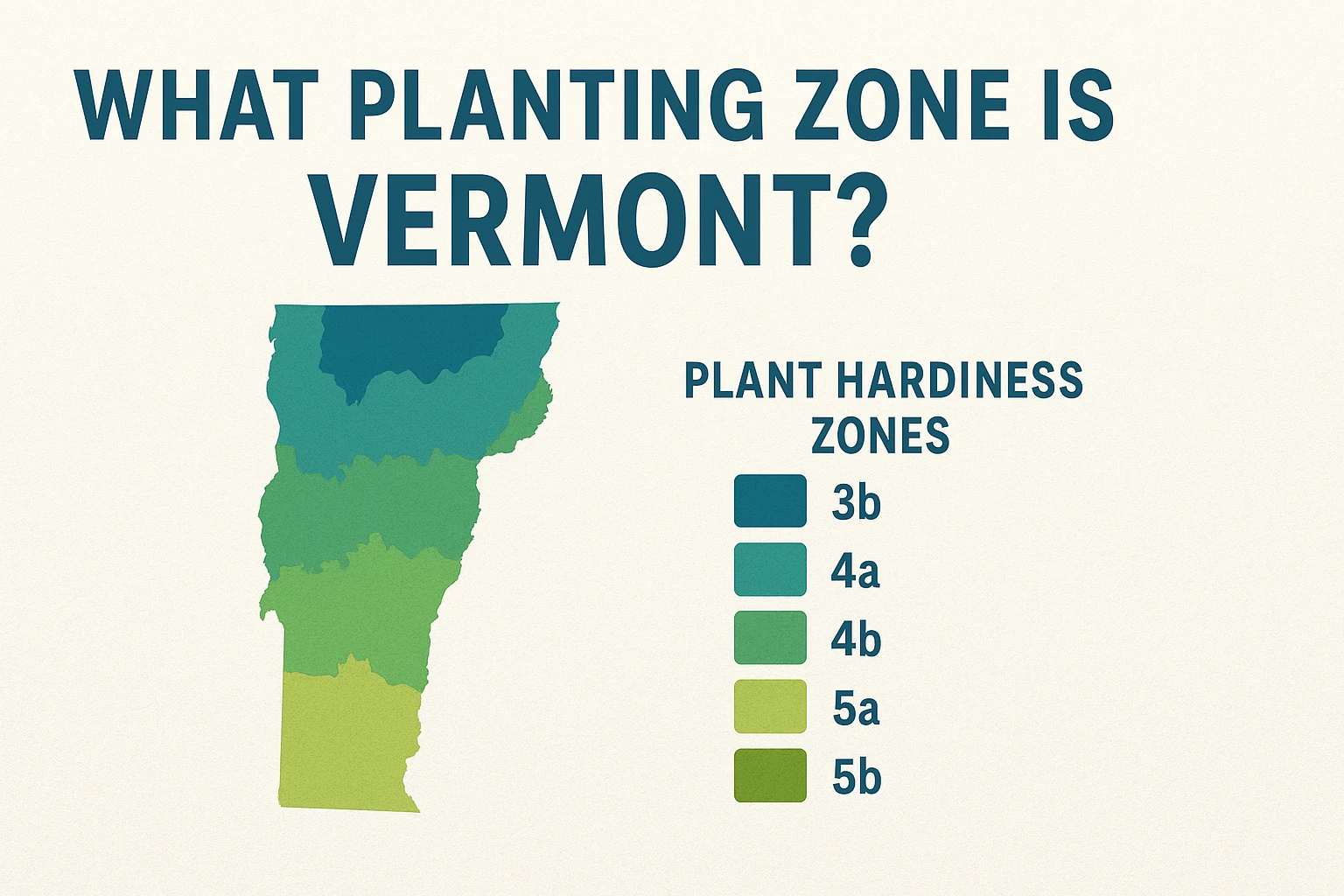What Planting Zone is Vermont?[Map, Cities, and Growing Tips]

Vermont’s planting zones range from 3b to 5b, with most of the state falling within zones 4a, 4b, and 5a. Northern Vermont includes zones 3b, 4a, and 4b, while southern Vermont is primarily in zone 5a and 5b.
Understanding what planting zone is Vermont helps gardeners choose plants suited to the region’s cold winters and short growing seasons. This guide will cover Vermont’s planting zones by region, how these zones affect gardening, and practical tips for growing successfully in the Green Mountain State.
🌱 What Planting Zone is Vermont?
If you’re wondering what planting zone is Vermont, the state spans USDA Hardiness Zones 3b through 5b.
| Region | USDA Zone |
|---|---|
| Northern Vermont (e.g., Newport) | Zone 3b, 4a |
| Central Vermont (e.g., Montpelier, Barre) | Zone 4b, 5a |
| Southern Vermont (e.g., Brattleboro, Bennington) | Zone 5a, 5b |
These zones are determined by average minimum winter temperatures, which are critical for choosing perennials, shrubs, and trees that can survive Vermont’s chilly winters.
📍 Vermont Planting Zones by City
For a more localized view of what planting zone is Vermont, here’s a breakdown by major cities:
| City | Planting Zone |
|---|---|
| Burlington | Zone 5a |
| Montpelier | Zone 4b |
| St. Johnsbury | Zone 4a |
| Brattleboro | Zone 5b |
| Bennington | Zone 5a |
| Newport | Zone 3b |
| Middlebury | Zone 5a |
| Barre | Zone 4b |
Microclimates caused by elevation, proximity to Lake Champlain, and valley locations can create subtle differences, so it’s always worth checking your specific zip code.
🌡️ Why Knowing What Planting Zone is Vermont Matters?
Understanding what planting zone is Vermont is crucial because it dictates:
- Which perennials will survive winter
- When to plant vegetables and annuals
- How long your growing season lasts
- What kinds of fruit trees will thrive
For instance, a plant hardy to Zone 6 won’t make it through a Zone 4 Vermont winter without serious protection. Knowing this upfront saves time, money, and frustration.
🧠 Real Example: Tomatoes in Vermont Zones
In Zone 5a (Burlington area), tomatoes are typically planted outdoors after Memorial Day, once the last frost has passed. However, in Zone 3b (Newport area), gardeners might wait until mid-June and often use row covers or hoop houses for extra protection.
Understanding what planting zone is Vermont helps plan your gardening calendar and avoid costly mistakes with tender plants.
📅 Vermont Planting Calendar Based on Zones
| Crop Type | Zone 3b-4a Start | Zone 4b-5a Start | Zone 5b Start |
|---|---|---|---|
| Cool-weather (lettuce, kale) | May | April | Late March |
| Warm-weather (tomatoes, peppers) | Mid-June | Late May | Late May |
| Perennials | Fall or early spring | Fall or early spring | Fall preferred |
This shows why knowing what planting zone is Vermont is essential before planting.
🌿 Tips for Gardening in Vermont’s Planting Zones
With Vermont’s cold winters and short summers, gardeners should adapt to maximize success:
✅ Do:
- Start seeds indoors early (March-April)
- Use cold frames or row covers to extend seasons
- Choose cold-hardy, short-season varieties
- Mulch heavily to protect roots over winter
❌ Avoid:
- Planting too early — frosts are stubborn in Vermont!
- Using tender perennials rated only for Zone 6+
- Ignoring soil health — Vermont’s rocky, acidic soils need amending
Understanding what planting zone is Vermont helps you adjust these practices to your specific location.
📍 Find Your Exact Vermont Zone by Zip Code
While this guide gives a state-wide overview, to get the most accurate answer to what planting zone is Vermont for my garden, check your exact zip code on the USDA Hardiness Zone Map.
🧮 Recommended Tools for Vermont Gardeners
- Soil Volume Calculator – Know exactly how much soil you need for raised beds.
- Plant Spacing Calculator – Prevent overcrowding and maximize yield.
- Indoor Plant Watering Calculator – Perfect for your houseplants or container garden.
✅ Frequently Asked Questions (FAQ)
What is the coldest planting zone in Vermont?
The coldest planting zone in Vermont is Zone 3b, found in higher elevations and northern regions like Newport.
Can I grow fruit trees in Vermont?
Yes, but focus on cold-hardy varieties like apples, pears, and cherries rated for Zones 3–5.
When is the last frost in Vermont?
In Zone 5b (Brattleboro), the last frost is usually mid-May. In Zone 3b, it can be as late as early June.
